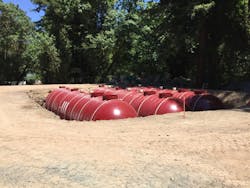Winery recycles 1.35M gallons of water with Napa Green-Certified wastewater treatment
CALISTOGA, CA, OCT 19, 2018 -- When its leach field failed, the owners of Napa Valley winery Castello di Amorosa knew it was time to reconsider their wastewater system. California had experienced a series of droughts, which resulted in increased water-use restrictions, and the need for wineries to reclaim and reuse the treated wastewater.
"The owner of the winery is very conscious about conserving natural resources on the property. A major drought in 2014 led us to be proactive and look for a replacement system that would save water," says Tim Dexter, maintenance manager at Castello di Amorosa.
The winery's environmental values drove them to search for the best treatment-system technology, design and tank material.
The fiberglass tank advantage
"Corrosion-resistant fiberglass ensures we can safely hold any type of wastewater, including winery wastewater, which contains a variety of chemicals and varied pH levels," explains Sheldon Sapoznik, owner of Wine to Water Sales Group and sales representative for BioMicrobics' winery wastewater treatment systems.
A precise treatment system for the winery's custom needs
"A major advantage of pairing ZCL | Xerxes tanks with the BioMicrobics treatment system is that together they are scalable and modular," says Sheldon.
Three ZCL | Xerxes 22,000-gallon/83,000-liter fiberglass wastewater tanks (10-foot-diameter) replaced the previous concrete tanks. A BioMicrobics' BioBarrier® HSMBR® (High Strength Membrane Bioreactor) treatment system is installed inside each tank. The aeration grids below the membrane modules promote aerobic microbes that metabolize and digest the wastewater, which then passes through the membranes.
The BioBarrier system's flat-sheet membranes have 0.03 to 1.3 micron pores, providing ultrafiltration. This physically separates the wastewater and treated water so solids and bacteria remain in the tank. The treated water (high-quality effluent), with nearly all contaminants removed, exits the tanks via a small submerged filtrate pump.
The three tanks operate independently to address the winery's wastewater flows, which can vary significantly day to day. During the most water-intensive times -- when wine is bottled and barrels are washed -- all three tank systems run. The BioBarrier HSMBR system in each tank can treat up to six gallons per minute. In a 24-hour period, the three tanks can treat up to 9,000 gallons/34,000 liters of water. The tanks are designed to accommodate the surge protection needed for this high volume of flow, so the treatment process isn't disrupted.
The Castello di Amorosa wastewater system is designed for low maintenance, and requires membrane cleaning and sludge removal only once per year.
Over 1.35 million gallons of water treated and reused in first year
The resulting clean water can be reused in numerous ways, including vineyard irrigation.
"In our first year of operation, ending in May 2018, the winery treated and reused 1.35 million gallons of water. That's the amount of water we would have had to source from somewhere else. Our water now has two life cycles," says Tim.
Both the winery and land have recently been Napa Green-certified, which means they meet all the regulatory components needed for environmental sustainability, including water conservation and efficiency.
Better together
ZCL| Xerxes and BioMicrobics work together in a variety of wastewater applications. Our partnership offers customers turnkey solutions, eliminating the need to source multiple components of a water treatment system from separate vendors. With a wide range of tank sizes and capacities, and the ability to customize accessories, we're able to meet customers' specific application needs in any size winery.






